Comparative Analysis: Endogenous Growth Model and Neoclassical Model
VerifiedAdded on 2023/01/12
|16
|3931
|50
Report
AI Summary
This report provides a comparative analysis of the endogenous and neoclassical growth models, focusing on their core principles and implications for economic development, particularly in the context of the Egyptian economy. The report begins with an introduction to both the Solow's neoclassical model and the endogenous growth model, explaining their fundamental assumptions and mechanisms. It then delves into a detailed comparison, highlighting key distinctions such as increasing versus decreasing returns to capital investment, increasing versus constant returns to scale, and externality effects. The analysis includes graphical representations to illustrate these concepts. The report concludes by summarizing the key differences between the two models and their relevance in understanding economic growth and the role of government policies. The report aims to provide a clear understanding of how these models contribute to the understanding of economic growth.
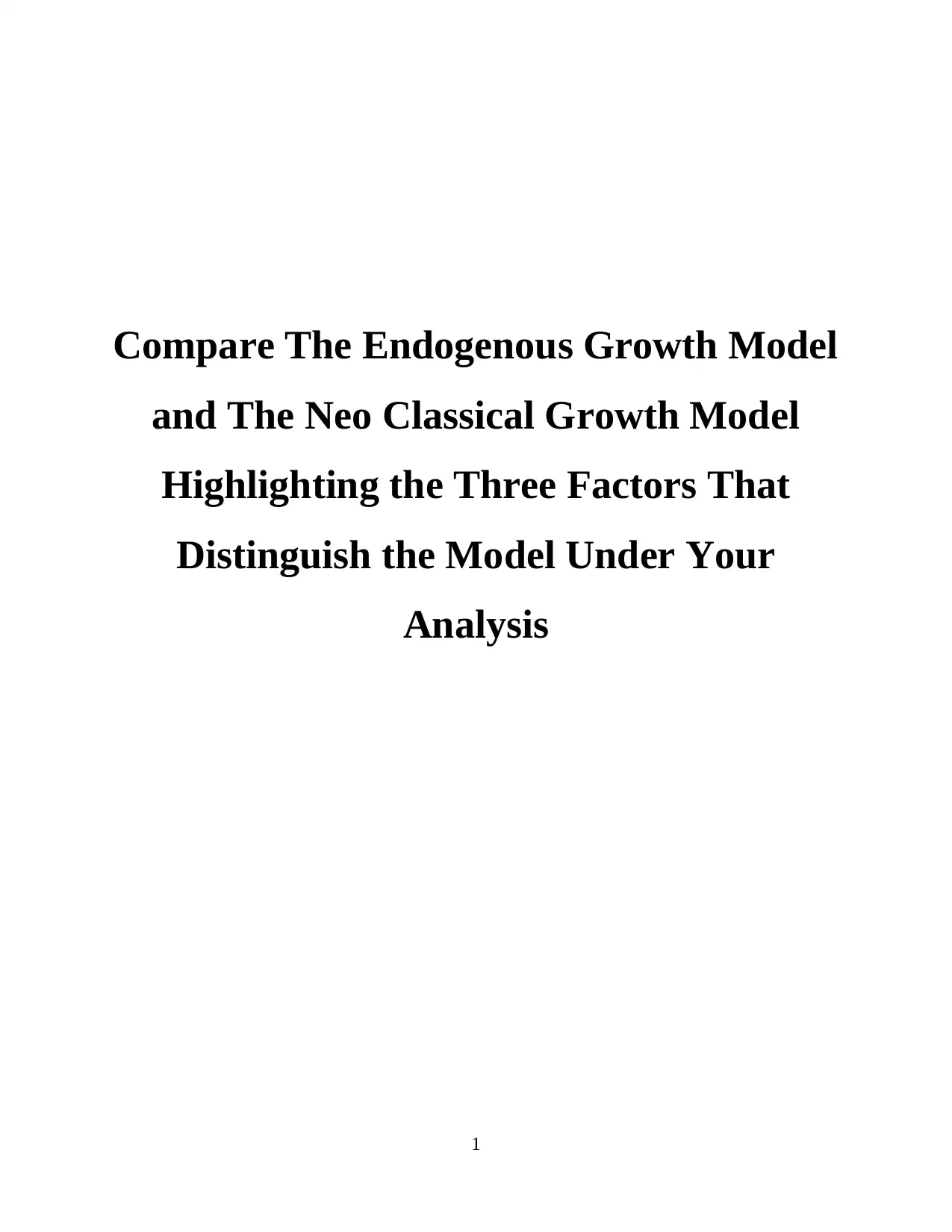
Compare The Endogenous Growth Model
and The Neo Classical Growth Model
Highlighting the Three Factors That
Distinguish the Model Under Your
Analysis
1
and The Neo Classical Growth Model
Highlighting the Three Factors That
Distinguish the Model Under Your
Analysis
1
Paraphrase This Document
Need a fresh take? Get an instant paraphrase of this document with our AI Paraphraser
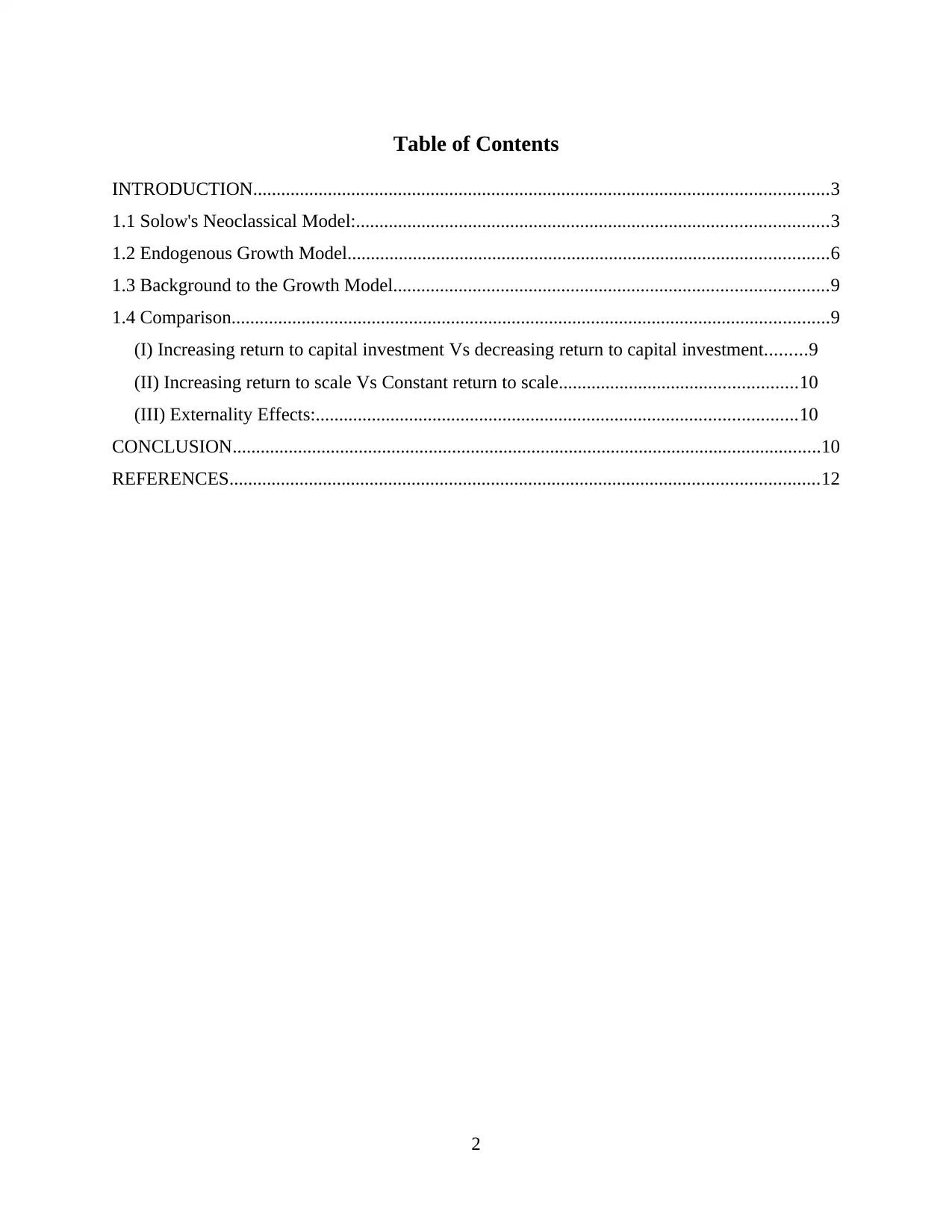
Table of Contents
INTRODUCTION...........................................................................................................................3
1.1 Solow's Neoclassical Model:.....................................................................................................3
1.2 Endogenous Growth Model.......................................................................................................6
1.3 Background to the Growth Model.............................................................................................9
1.4 Comparison................................................................................................................................9
(I) Increasing return to capital investment Vs decreasing return to capital investment.........9
(II) Increasing return to scale Vs Constant return to scale...................................................10
(III) Externality Effects:.......................................................................................................10
CONCLUSION..............................................................................................................................10
REFERENCES..............................................................................................................................12
2
INTRODUCTION...........................................................................................................................3
1.1 Solow's Neoclassical Model:.....................................................................................................3
1.2 Endogenous Growth Model.......................................................................................................6
1.3 Background to the Growth Model.............................................................................................9
1.4 Comparison................................................................................................................................9
(I) Increasing return to capital investment Vs decreasing return to capital investment.........9
(II) Increasing return to scale Vs Constant return to scale...................................................10
(III) Externality Effects:.......................................................................................................10
CONCLUSION..............................................................................................................................10
REFERENCES..............................................................................................................................12
2
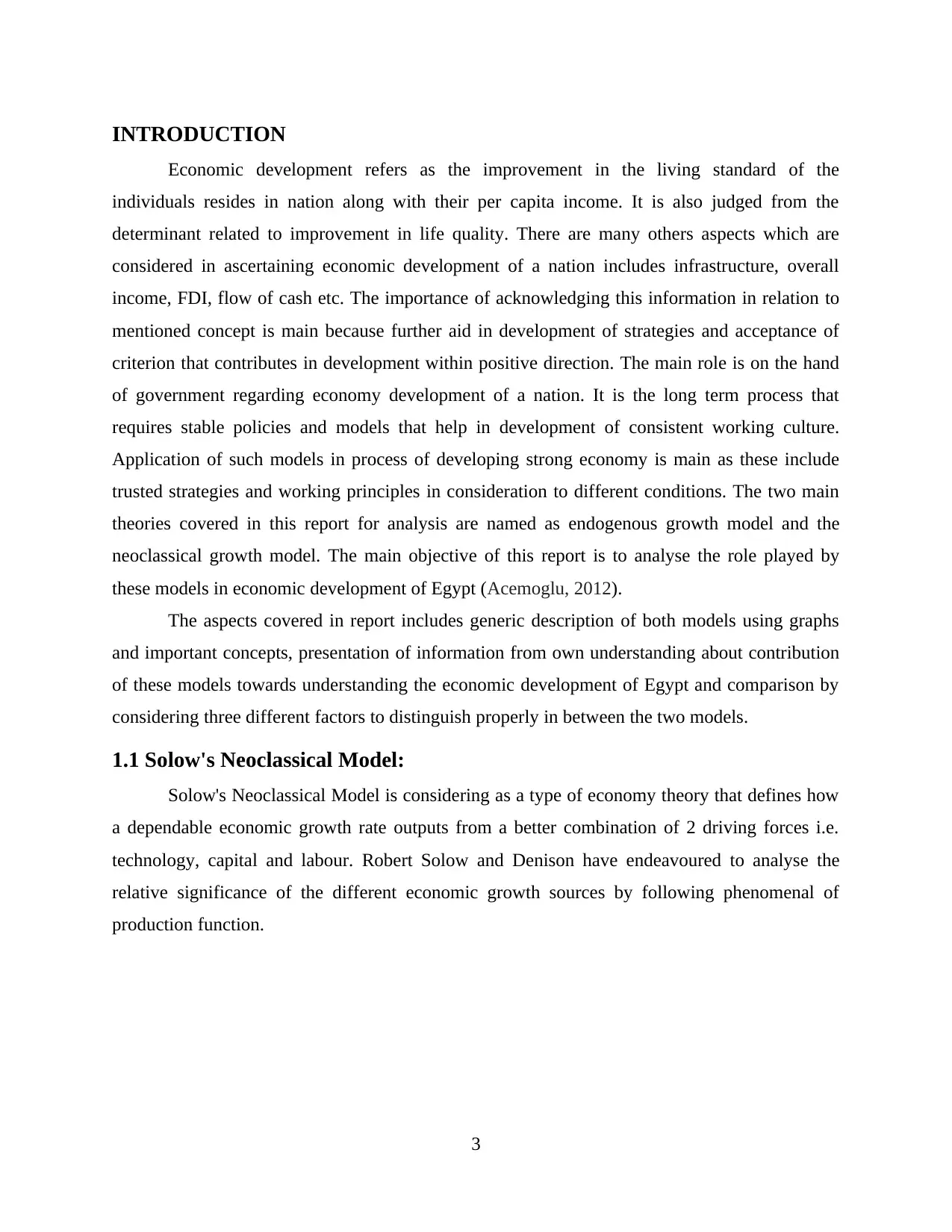
INTRODUCTION
Economic development refers as the improvement in the living standard of the
individuals resides in nation along with their per capita income. It is also judged from the
determinant related to improvement in life quality. There are many others aspects which are
considered in ascertaining economic development of a nation includes infrastructure, overall
income, FDI, flow of cash etc. The importance of acknowledging this information in relation to
mentioned concept is main because further aid in development of strategies and acceptance of
criterion that contributes in development within positive direction. The main role is on the hand
of government regarding economy development of a nation. It is the long term process that
requires stable policies and models that help in development of consistent working culture.
Application of such models in process of developing strong economy is main as these include
trusted strategies and working principles in consideration to different conditions. The two main
theories covered in this report for analysis are named as endogenous growth model and the
neoclassical growth model. The main objective of this report is to analyse the role played by
these models in economic development of Egypt (Acemoglu, 2012).
The aspects covered in report includes generic description of both models using graphs
and important concepts, presentation of information from own understanding about contribution
of these models towards understanding the economic development of Egypt and comparison by
considering three different factors to distinguish properly in between the two models.
1.1 Solow's Neoclassical Model:
Solow's Neoclassical Model is considering as a type of economy theory that defines how
a dependable economic growth rate outputs from a better combination of 2 driving forces i.e.
technology, capital and labour. Robert Solow and Denison have endeavoured to analyse the
relative significance of the different economic growth sources by following phenomenal of
production function.
3
Economic development refers as the improvement in the living standard of the
individuals resides in nation along with their per capita income. It is also judged from the
determinant related to improvement in life quality. There are many others aspects which are
considered in ascertaining economic development of a nation includes infrastructure, overall
income, FDI, flow of cash etc. The importance of acknowledging this information in relation to
mentioned concept is main because further aid in development of strategies and acceptance of
criterion that contributes in development within positive direction. The main role is on the hand
of government regarding economy development of a nation. It is the long term process that
requires stable policies and models that help in development of consistent working culture.
Application of such models in process of developing strong economy is main as these include
trusted strategies and working principles in consideration to different conditions. The two main
theories covered in this report for analysis are named as endogenous growth model and the
neoclassical growth model. The main objective of this report is to analyse the role played by
these models in economic development of Egypt (Acemoglu, 2012).
The aspects covered in report includes generic description of both models using graphs
and important concepts, presentation of information from own understanding about contribution
of these models towards understanding the economic development of Egypt and comparison by
considering three different factors to distinguish properly in between the two models.
1.1 Solow's Neoclassical Model:
Solow's Neoclassical Model is considering as a type of economy theory that defines how
a dependable economic growth rate outputs from a better combination of 2 driving forces i.e.
technology, capital and labour. Robert Solow and Denison have endeavoured to analyse the
relative significance of the different economic growth sources by following phenomenal of
production function.
3
⊘ This is a preview!⊘
Do you want full access?
Subscribe today to unlock all pages.

Trusted by 1+ million students worldwide

Figure 1Solow's Neoclassical Model
There is huge contribution of this theory in understanding the contribution of different
number of factors that help in determination of rate of economic growth in relation to the
different nations. The aspect of growth is refers as adding more capital, labour inputs, idea and
technology for further performance of work in more enhanced manner. There are many basic
points upon which this model defines the aspect of economic growth. The different determinants
in relation to same are defined below:
The model has belief that temporary increase will be seen in growth rate after attaining
sustainable rise in capital investment. The main reason behind occurrence of this situation
will be increased ratio of capital to labour that continually goes up.
If, ascertained the decline in marginal product of additional units then the economy
moves back towards long term growth path. This will be ascertained in the situation when
the real GDP growing at the same rate as the development ascertained in workforce plus
a factor to reflect improving productivity (Acs, et. al., 2012).
This models states that steady state of growth path is ascertained in the situation when
capital, output and labour are growing with same rate. This is the situation when output
per worker and capital per worker are constant in nature.
As per the belief of neoclassical economists that a raise in the trend rate of growth will
gathered in the situation when attained the combined situation related to addition in the
labour supply and a higher level of fruitfulness of labour and capital.
4
There is huge contribution of this theory in understanding the contribution of different
number of factors that help in determination of rate of economic growth in relation to the
different nations. The aspect of growth is refers as adding more capital, labour inputs, idea and
technology for further performance of work in more enhanced manner. There are many basic
points upon which this model defines the aspect of economic growth. The different determinants
in relation to same are defined below:
The model has belief that temporary increase will be seen in growth rate after attaining
sustainable rise in capital investment. The main reason behind occurrence of this situation
will be increased ratio of capital to labour that continually goes up.
If, ascertained the decline in marginal product of additional units then the economy
moves back towards long term growth path. This will be ascertained in the situation when
the real GDP growing at the same rate as the development ascertained in workforce plus
a factor to reflect improving productivity (Acs, et. al., 2012).
This models states that steady state of growth path is ascertained in the situation when
capital, output and labour are growing with same rate. This is the situation when output
per worker and capital per worker are constant in nature.
As per the belief of neoclassical economists that a raise in the trend rate of growth will
gathered in the situation when attained the combined situation related to addition in the
labour supply and a higher level of fruitfulness of labour and capital.
4
Paraphrase This Document
Need a fresh take? Get an instant paraphrase of this document with our AI Paraphraser
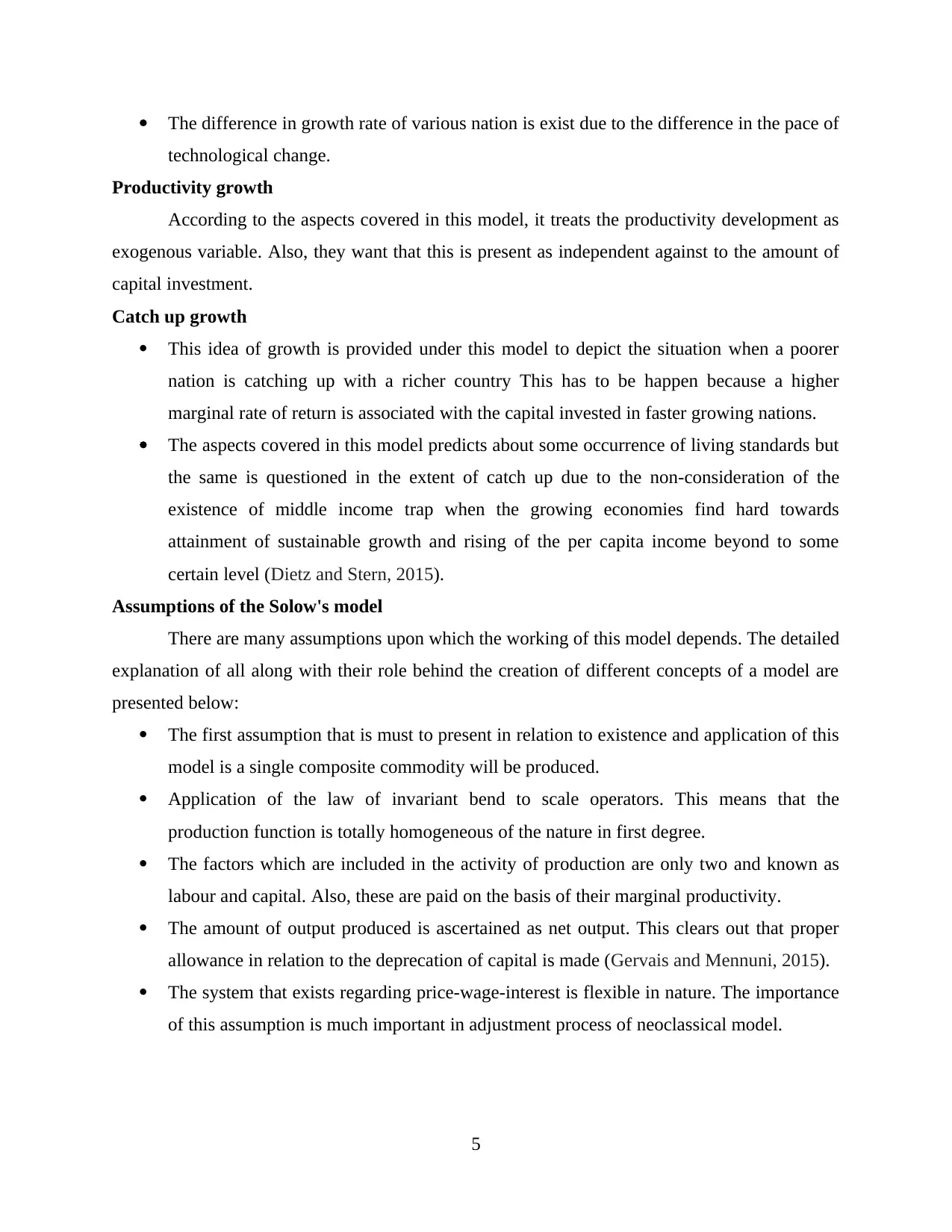
The difference in growth rate of various nation is exist due to the difference in the pace of
technological change.
Productivity growth
According to the aspects covered in this model, it treats the productivity development as
exogenous variable. Also, they want that this is present as independent against to the amount of
capital investment.
Catch up growth
This idea of growth is provided under this model to depict the situation when a poorer
nation is catching up with a richer country This has to be happen because a higher
marginal rate of return is associated with the capital invested in faster growing nations.
The aspects covered in this model predicts about some occurrence of living standards but
the same is questioned in the extent of catch up due to the non-consideration of the
existence of middle income trap when the growing economies find hard towards
attainment of sustainable growth and rising of the per capita income beyond to some
certain level (Dietz and Stern, 2015).
Assumptions of the Solow's model
There are many assumptions upon which the working of this model depends. The detailed
explanation of all along with their role behind the creation of different concepts of a model are
presented below:
The first assumption that is must to present in relation to existence and application of this
model is a single composite commodity will be produced.
Application of the law of invariant bend to scale operators. This means that the
production function is totally homogeneous of the nature in first degree.
The factors which are included in the activity of production are only two and known as
labour and capital. Also, these are paid on the basis of their marginal productivity.
The amount of output produced is ascertained as net output. This clears out that proper
allowance in relation to the deprecation of capital is made (Gervais and Mennuni, 2015).
The system that exists regarding price-wage-interest is flexible in nature. The importance
of this assumption is much important in adjustment process of neoclassical model.
5
technological change.
Productivity growth
According to the aspects covered in this model, it treats the productivity development as
exogenous variable. Also, they want that this is present as independent against to the amount of
capital investment.
Catch up growth
This idea of growth is provided under this model to depict the situation when a poorer
nation is catching up with a richer country This has to be happen because a higher
marginal rate of return is associated with the capital invested in faster growing nations.
The aspects covered in this model predicts about some occurrence of living standards but
the same is questioned in the extent of catch up due to the non-consideration of the
existence of middle income trap when the growing economies find hard towards
attainment of sustainable growth and rising of the per capita income beyond to some
certain level (Dietz and Stern, 2015).
Assumptions of the Solow's model
There are many assumptions upon which the working of this model depends. The detailed
explanation of all along with their role behind the creation of different concepts of a model are
presented below:
The first assumption that is must to present in relation to existence and application of this
model is a single composite commodity will be produced.
Application of the law of invariant bend to scale operators. This means that the
production function is totally homogeneous of the nature in first degree.
The factors which are included in the activity of production are only two and known as
labour and capital. Also, these are paid on the basis of their marginal productivity.
The amount of output produced is ascertained as net output. This clears out that proper
allowance in relation to the deprecation of capital is made (Gervais and Mennuni, 2015).
The system that exists regarding price-wage-interest is flexible in nature. The importance
of this assumption is much important in adjustment process of neoclassical model.
5
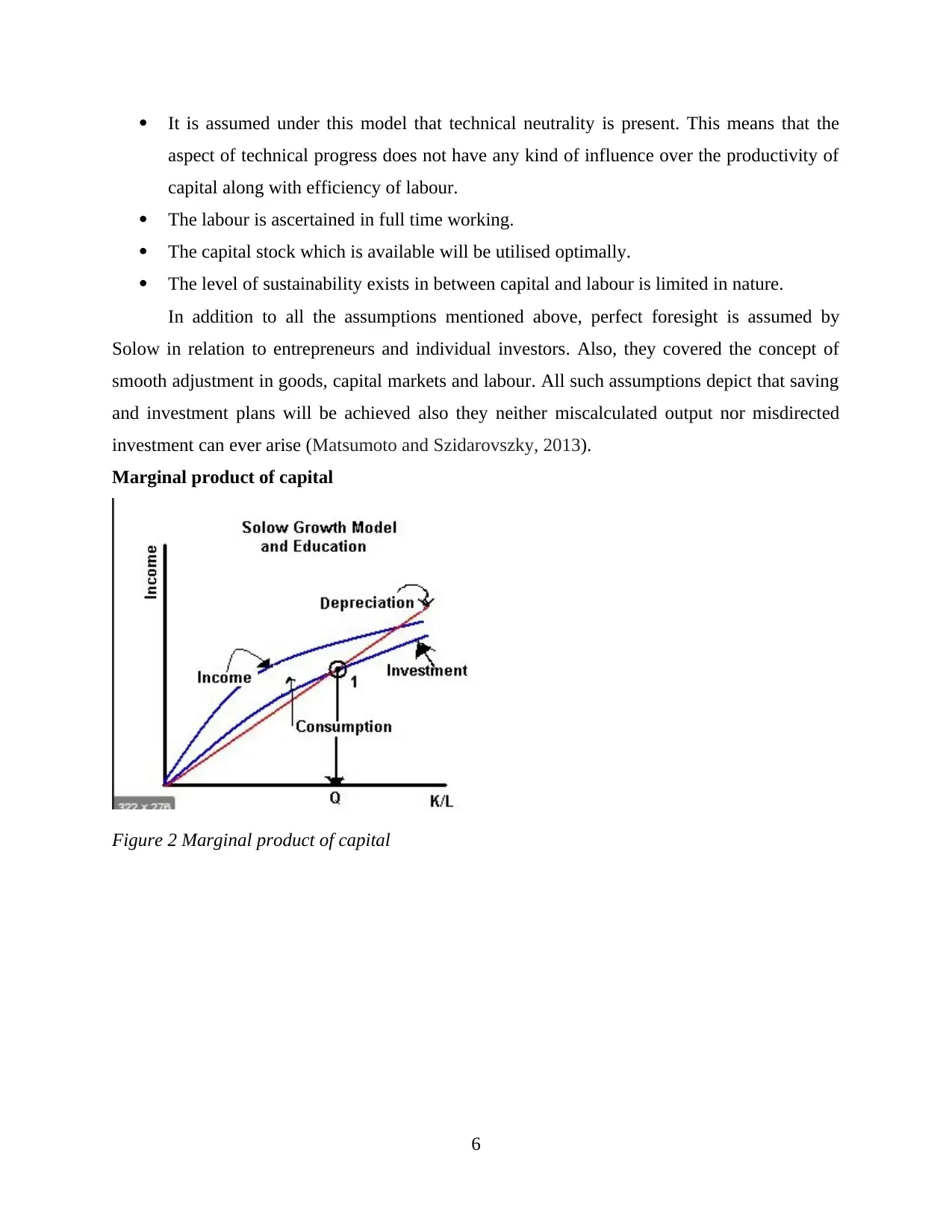
It is assumed under this model that technical neutrality is present. This means that the
aspect of technical progress does not have any kind of influence over the productivity of
capital along with efficiency of labour.
The labour is ascertained in full time working.
The capital stock which is available will be utilised optimally.
The level of sustainability exists in between capital and labour is limited in nature.
In addition to all the assumptions mentioned above, perfect foresight is assumed by
Solow in relation to entrepreneurs and individual investors. Also, they covered the concept of
smooth adjustment in goods, capital markets and labour. All such assumptions depict that saving
and investment plans will be achieved also they neither miscalculated output nor misdirected
investment can ever arise (Matsumoto and Szidarovszky, 2013).
Marginal product of capital
Figure 2 Marginal product of capital
6
aspect of technical progress does not have any kind of influence over the productivity of
capital along with efficiency of labour.
The labour is ascertained in full time working.
The capital stock which is available will be utilised optimally.
The level of sustainability exists in between capital and labour is limited in nature.
In addition to all the assumptions mentioned above, perfect foresight is assumed by
Solow in relation to entrepreneurs and individual investors. Also, they covered the concept of
smooth adjustment in goods, capital markets and labour. All such assumptions depict that saving
and investment plans will be achieved also they neither miscalculated output nor misdirected
investment can ever arise (Matsumoto and Szidarovszky, 2013).
Marginal product of capital
Figure 2 Marginal product of capital
6
⊘ This is a preview!⊘
Do you want full access?
Subscribe today to unlock all pages.

Trusted by 1+ million students worldwide
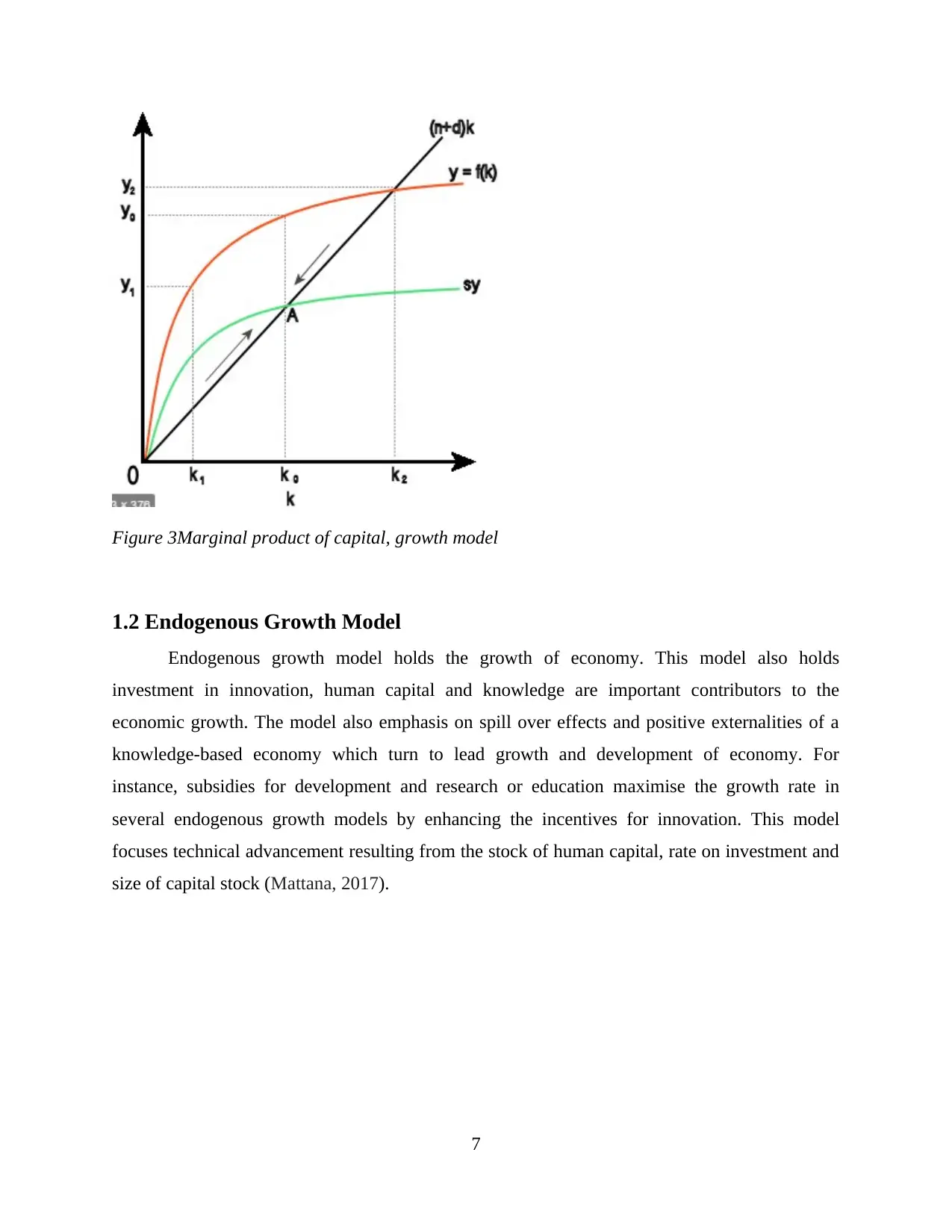
Figure 3Marginal product of capital, growth model
1.2 Endogenous Growth Model
Endogenous growth model holds the growth of economy. This model also holds
investment in innovation, human capital and knowledge are important contributors to the
economic growth. The model also emphasis on spill over effects and positive externalities of a
knowledge-based economy which turn to lead growth and development of economy. For
instance, subsidies for development and research or education maximise the growth rate in
several endogenous growth models by enhancing the incentives for innovation. This model
focuses technical advancement resulting from the stock of human capital, rate on investment and
size of capital stock (Mattana, 2017).
7
1.2 Endogenous Growth Model
Endogenous growth model holds the growth of economy. This model also holds
investment in innovation, human capital and knowledge are important contributors to the
economic growth. The model also emphasis on spill over effects and positive externalities of a
knowledge-based economy which turn to lead growth and development of economy. For
instance, subsidies for development and research or education maximise the growth rate in
several endogenous growth models by enhancing the incentives for innovation. This model
focuses technical advancement resulting from the stock of human capital, rate on investment and
size of capital stock (Mattana, 2017).
7
Paraphrase This Document
Need a fresh take? Get an instant paraphrase of this document with our AI Paraphraser
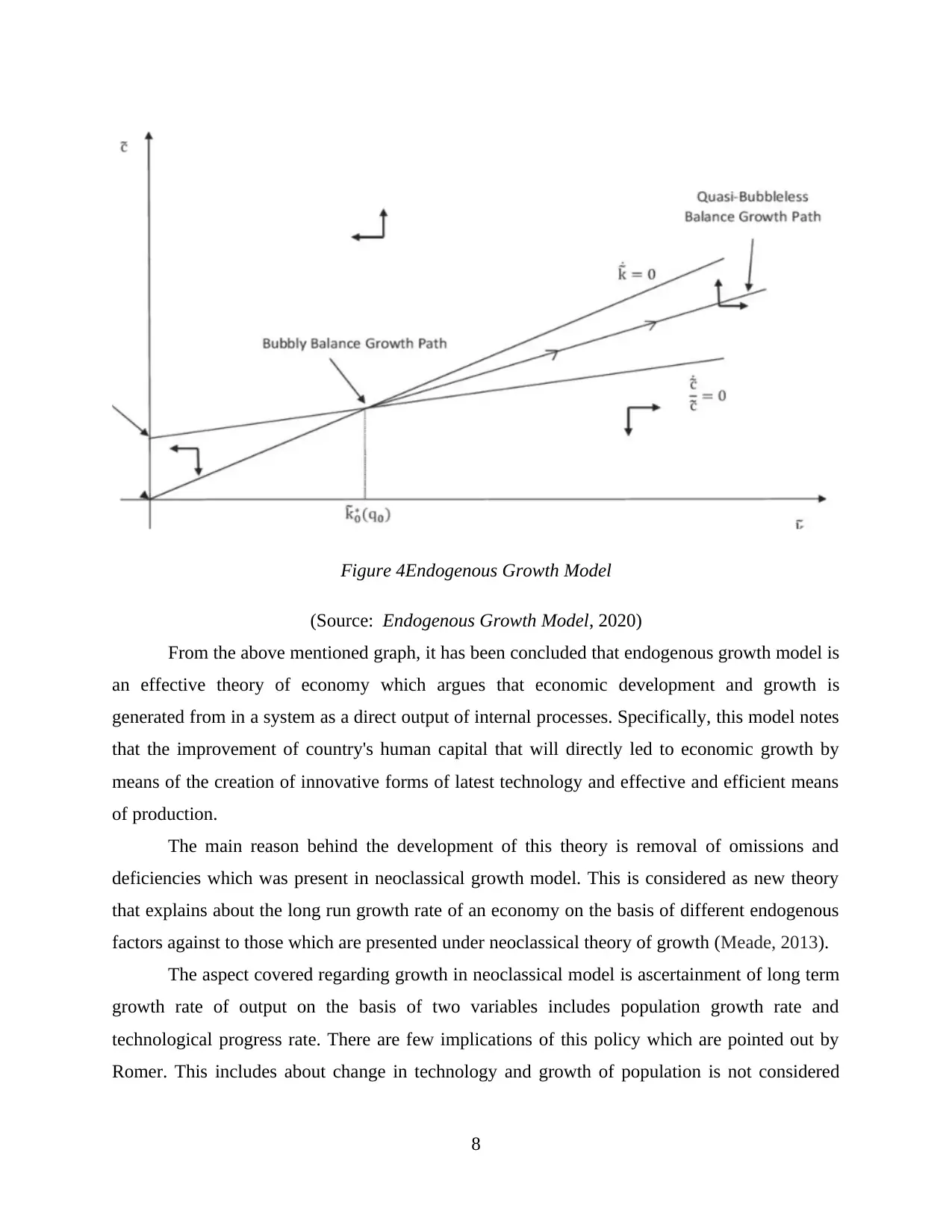
Figure 4Endogenous Growth Model
(Source: Endogenous Growth Model, 2020)
From the above mentioned graph, it has been concluded that endogenous growth model is
an effective theory of economy which argues that economic development and growth is
generated from in a system as a direct output of internal processes. Specifically, this model notes
that the improvement of country's human capital that will directly led to economic growth by
means of the creation of innovative forms of latest technology and effective and efficient means
of production.
The main reason behind the development of this theory is removal of omissions and
deficiencies which was present in neoclassical growth model. This is considered as new theory
that explains about the long run growth rate of an economy on the basis of different endogenous
factors against to those which are presented under neoclassical theory of growth (Meade, 2013).
The aspect covered regarding growth in neoclassical model is ascertainment of long term
growth rate of output on the basis of two variables includes population growth rate and
technological progress rate. There are few implications of this policy which are pointed out by
Romer. This includes about change in technology and growth of population is not considered
8
(Source: Endogenous Growth Model, 2020)
From the above mentioned graph, it has been concluded that endogenous growth model is
an effective theory of economy which argues that economic development and growth is
generated from in a system as a direct output of internal processes. Specifically, this model notes
that the improvement of country's human capital that will directly led to economic growth by
means of the creation of innovative forms of latest technology and effective and efficient means
of production.
The main reason behind the development of this theory is removal of omissions and
deficiencies which was present in neoclassical growth model. This is considered as new theory
that explains about the long run growth rate of an economy on the basis of different endogenous
factors against to those which are presented under neoclassical theory of growth (Meade, 2013).
The aspect covered regarding growth in neoclassical model is ascertainment of long term
growth rate of output on the basis of two variables includes population growth rate and
technological progress rate. There are few implications of this policy which are pointed out by
Romer. This includes about change in technology and growth of population is not considered
8

along with not provide the importance over the point that what government did in relation to this
factor.
The new growth theory not simply criticise the neoclassical theory of growth. It improves
the concept by providence of endogenous technical progress in growth models. The model
related to endogenous growth is developed by many economists includes Arrow, Romer, Lucas
etc.
The emphases of endogenous growth model is over technical progress ascertained from
the rate of investment, size of the capital stock and the stock of human capital (Sandri, 2014).
Assumptions
The different assumptions upon which the aspects of this model are based. All these
assumptions in relation to this new growth model are presented below:
There are many firms exist in market.
Technological advance and knowledge are considered as non-rival good.
The increasing returns to scale all factors will be taken together and on the other hand
constant returns to a single factor, at least for one.
The different things which are comes from people will be the reason behind technological
advance. This clearly depicts that technological advancement is totally based over new
ideas.
The different number of firms and individuals have market power that allowed to earn
profit from their market discoveries. The main reason behind the creation of this
assumption that increasing returns to scale in production leads to imperfect competition
(Nirei and Aoki, 2016).
The three different or main models are existing in relation to explain endogenous growth
which are presented below:
The Arrow Model: He is the first economist the provides the concept related to the
learning by doing in 1962, This concept is provided as endogenous in the process of growth.
The levhari-Sheshinki Model: The model is further extended by Levhari and Sheshinki.
They both provide emphasise over the point that spill over effects of increased knowledge is
exist as source of knowledge. They have assumption that source of knowledge and learning is
considered as investment for an organisation.
9
factor.
The new growth theory not simply criticise the neoclassical theory of growth. It improves
the concept by providence of endogenous technical progress in growth models. The model
related to endogenous growth is developed by many economists includes Arrow, Romer, Lucas
etc.
The emphases of endogenous growth model is over technical progress ascertained from
the rate of investment, size of the capital stock and the stock of human capital (Sandri, 2014).
Assumptions
The different assumptions upon which the aspects of this model are based. All these
assumptions in relation to this new growth model are presented below:
There are many firms exist in market.
Technological advance and knowledge are considered as non-rival good.
The increasing returns to scale all factors will be taken together and on the other hand
constant returns to a single factor, at least for one.
The different things which are comes from people will be the reason behind technological
advance. This clearly depicts that technological advancement is totally based over new
ideas.
The different number of firms and individuals have market power that allowed to earn
profit from their market discoveries. The main reason behind the creation of this
assumption that increasing returns to scale in production leads to imperfect competition
(Nirei and Aoki, 2016).
The three different or main models are existing in relation to explain endogenous growth
which are presented below:
The Arrow Model: He is the first economist the provides the concept related to the
learning by doing in 1962, This concept is provided as endogenous in the process of growth.
The levhari-Sheshinki Model: The model is further extended by Levhari and Sheshinki.
They both provide emphasise over the point that spill over effects of increased knowledge is
exist as source of knowledge. They have assumption that source of knowledge and learning is
considered as investment for an organisation.
9
⊘ This is a preview!⊘
Do you want full access?
Subscribe today to unlock all pages.

Trusted by 1+ million students worldwide
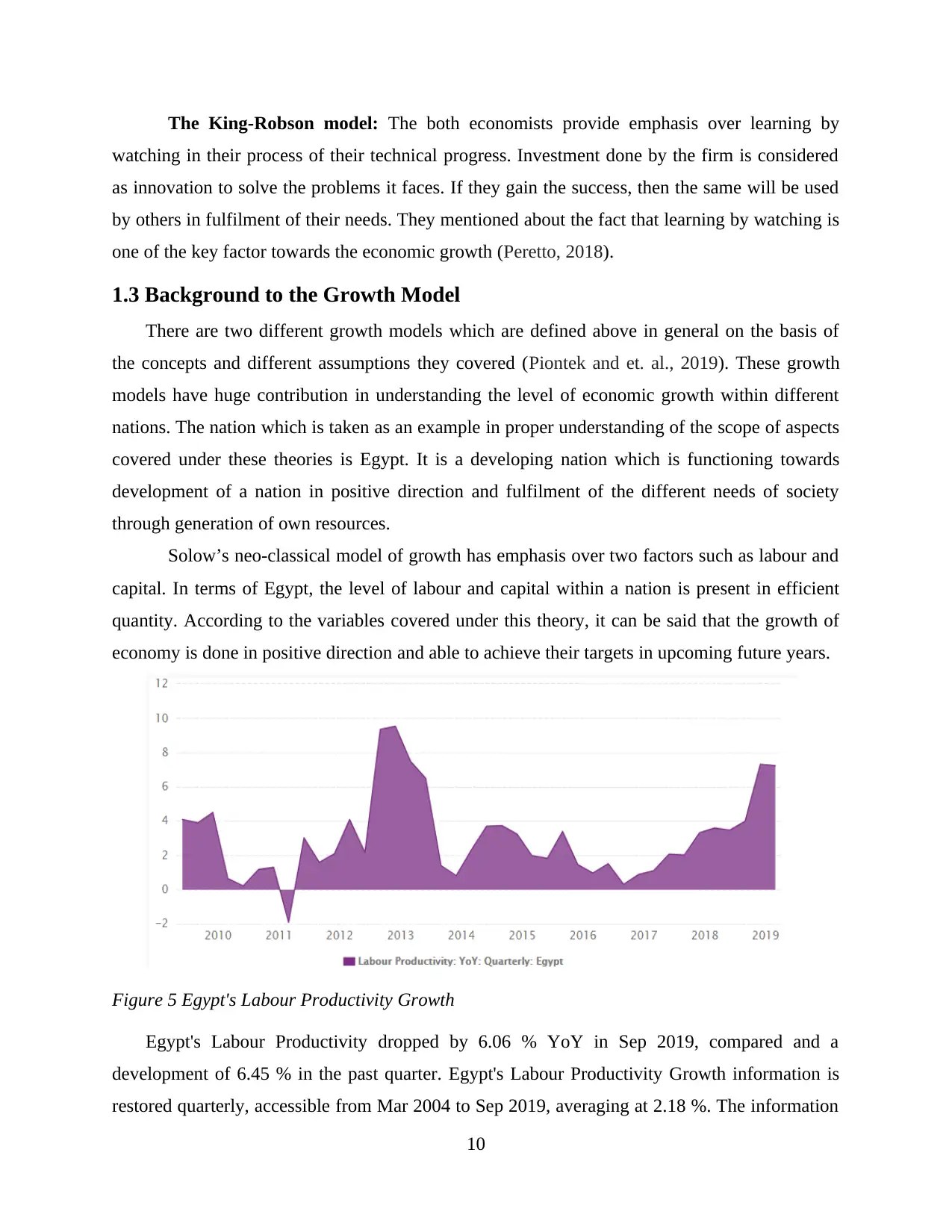
The King-Robson model: The both economists provide emphasis over learning by
watching in their process of their technical progress. Investment done by the firm is considered
as innovation to solve the problems it faces. If they gain the success, then the same will be used
by others in fulfilment of their needs. They mentioned about the fact that learning by watching is
one of the key factor towards the economic growth (Peretto, 2018).
1.3 Background to the Growth Model
There are two different growth models which are defined above in general on the basis of
the concepts and different assumptions they covered (Piontek and et. al., 2019). These growth
models have huge contribution in understanding the level of economic growth within different
nations. The nation which is taken as an example in proper understanding of the scope of aspects
covered under these theories is Egypt. It is a developing nation which is functioning towards
development of a nation in positive direction and fulfilment of the different needs of society
through generation of own resources.
Solow’s neo-classical model of growth has emphasis over two factors such as labour and
capital. In terms of Egypt, the level of labour and capital within a nation is present in efficient
quantity. According to the variables covered under this theory, it can be said that the growth of
economy is done in positive direction and able to achieve their targets in upcoming future years.
Figure 5 Egypt's Labour Productivity Growth
Egypt's Labour Productivity dropped by 6.06 % YoY in Sep 2019, compared and a
development of 6.45 % in the past quarter. Egypt's Labour Productivity Growth information is
restored quarterly, accessible from Mar 2004 to Sep 2019, averaging at 2.18 %. The information
10
watching in their process of their technical progress. Investment done by the firm is considered
as innovation to solve the problems it faces. If they gain the success, then the same will be used
by others in fulfilment of their needs. They mentioned about the fact that learning by watching is
one of the key factor towards the economic growth (Peretto, 2018).
1.3 Background to the Growth Model
There are two different growth models which are defined above in general on the basis of
the concepts and different assumptions they covered (Piontek and et. al., 2019). These growth
models have huge contribution in understanding the level of economic growth within different
nations. The nation which is taken as an example in proper understanding of the scope of aspects
covered under these theories is Egypt. It is a developing nation which is functioning towards
development of a nation in positive direction and fulfilment of the different needs of society
through generation of own resources.
Solow’s neo-classical model of growth has emphasis over two factors such as labour and
capital. In terms of Egypt, the level of labour and capital within a nation is present in efficient
quantity. According to the variables covered under this theory, it can be said that the growth of
economy is done in positive direction and able to achieve their targets in upcoming future years.
Figure 5 Egypt's Labour Productivity Growth
Egypt's Labour Productivity dropped by 6.06 % YoY in Sep 2019, compared and a
development of 6.45 % in the past quarter. Egypt's Labour Productivity Growth information is
restored quarterly, accessible from Mar 2004 to Sep 2019, averaging at 2.18 %. The information
10
Paraphrase This Document
Need a fresh take? Get an instant paraphrase of this document with our AI Paraphraser
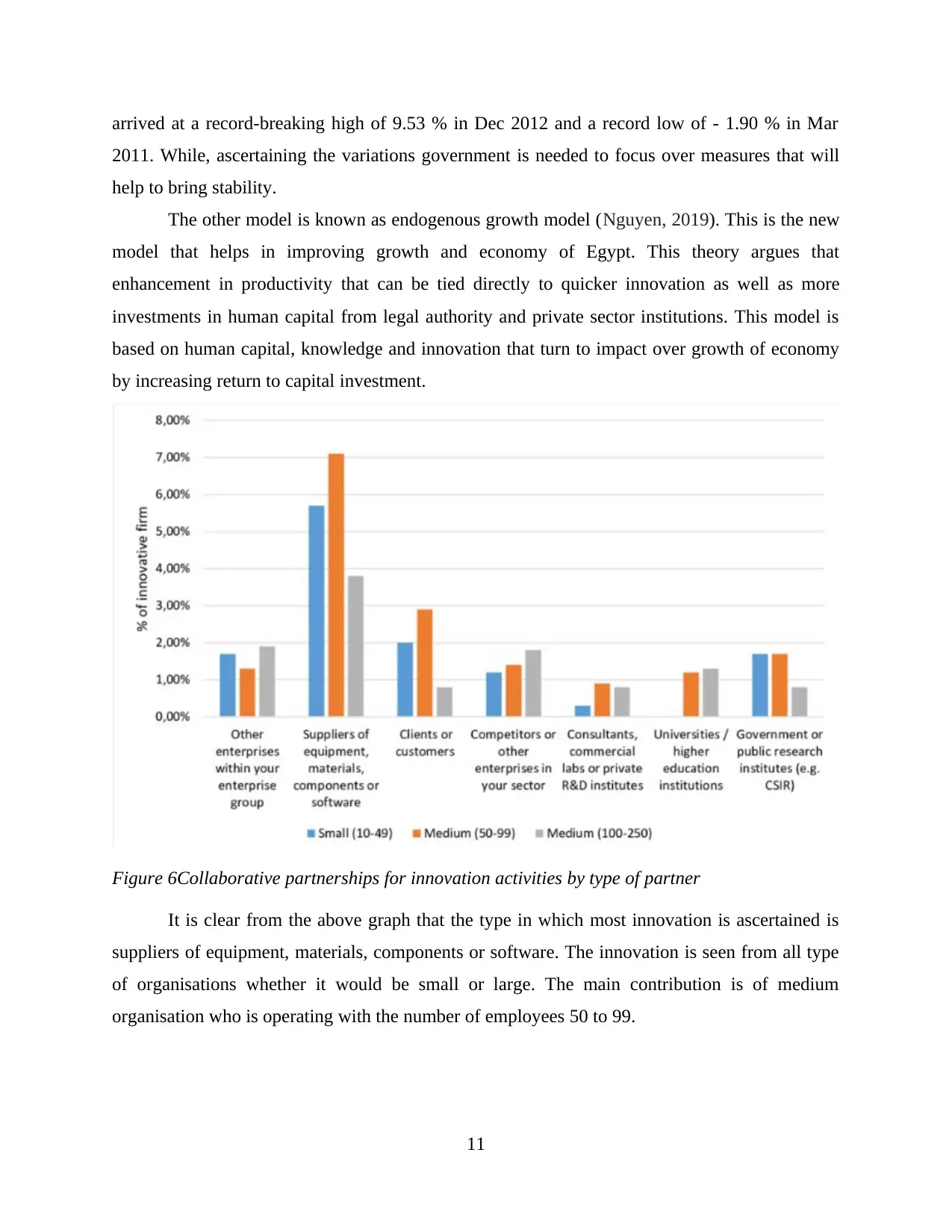
arrived at a record-breaking high of 9.53 % in Dec 2012 and a record low of - 1.90 % in Mar
2011. While, ascertaining the variations government is needed to focus over measures that will
help to bring stability.
The other model is known as endogenous growth model (Nguyen, 2019). This is the new
model that helps in improving growth and economy of Egypt. This theory argues that
enhancement in productivity that can be tied directly to quicker innovation as well as more
investments in human capital from legal authority and private sector institutions. This model is
based on human capital, knowledge and innovation that turn to impact over growth of economy
by increasing return to capital investment.
Figure 6Collaborative partnerships for innovation activities by type of partner
It is clear from the above graph that the type in which most innovation is ascertained is
suppliers of equipment, materials, components or software. The innovation is seen from all type
of organisations whether it would be small or large. The main contribution is of medium
organisation who is operating with the number of employees 50 to 99.
11
2011. While, ascertaining the variations government is needed to focus over measures that will
help to bring stability.
The other model is known as endogenous growth model (Nguyen, 2019). This is the new
model that helps in improving growth and economy of Egypt. This theory argues that
enhancement in productivity that can be tied directly to quicker innovation as well as more
investments in human capital from legal authority and private sector institutions. This model is
based on human capital, knowledge and innovation that turn to impact over growth of economy
by increasing return to capital investment.
Figure 6Collaborative partnerships for innovation activities by type of partner
It is clear from the above graph that the type in which most innovation is ascertained is
suppliers of equipment, materials, components or software. The innovation is seen from all type
of organisations whether it would be small or large. The main contribution is of medium
organisation who is operating with the number of employees 50 to 99.
11

Figure 7Egypt GDP Growth Rate
Egypt has one of the most created and expanded economies in the Middle East. Until 2010,
Egyptian economy was growing a normal 5 percent a quarter because of a few financial changes
pulling in inaccessible assumptions. During that time, the economy and the expectations for
everyday comforts for majority of population is improved.
1.4 Comparison
(I) Increasing return to capital investment Vs decreasing return to capital investment
Solow’s neo-classical model is a kind of growth model that is depends of human capital
and labour as it facilitates in growth of Egypt economy. It will also support country by increasing
its return to capital investment. The law of rising returns is the reverse of the law of
diminishing returns. Where the law of declining returns operates, all
extra investment of capital as well as labour yields less than fair returns (Dosi, G., Roventini, A.
and Russo, 2019). But, in context of increasing returns, the return to capital investment is more
than proportionate return.
12
Egypt has one of the most created and expanded economies in the Middle East. Until 2010,
Egyptian economy was growing a normal 5 percent a quarter because of a few financial changes
pulling in inaccessible assumptions. During that time, the economy and the expectations for
everyday comforts for majority of population is improved.
1.4 Comparison
(I) Increasing return to capital investment Vs decreasing return to capital investment
Solow’s neo-classical model is a kind of growth model that is depends of human capital
and labour as it facilitates in growth of Egypt economy. It will also support country by increasing
its return to capital investment. The law of rising returns is the reverse of the law of
diminishing returns. Where the law of declining returns operates, all
extra investment of capital as well as labour yields less than fair returns (Dosi, G., Roventini, A.
and Russo, 2019). But, in context of increasing returns, the return to capital investment is more
than proportionate return.
12
⊘ This is a preview!⊘
Do you want full access?
Subscribe today to unlock all pages.

Trusted by 1+ million students worldwide
1 out of 16
Related Documents
Your All-in-One AI-Powered Toolkit for Academic Success.
+13062052269
info@desklib.com
Available 24*7 on WhatsApp / Email
![[object Object]](/_next/static/media/star-bottom.7253800d.svg)
Unlock your academic potential
Copyright © 2020–2025 A2Z Services. All Rights Reserved. Developed and managed by ZUCOL.





